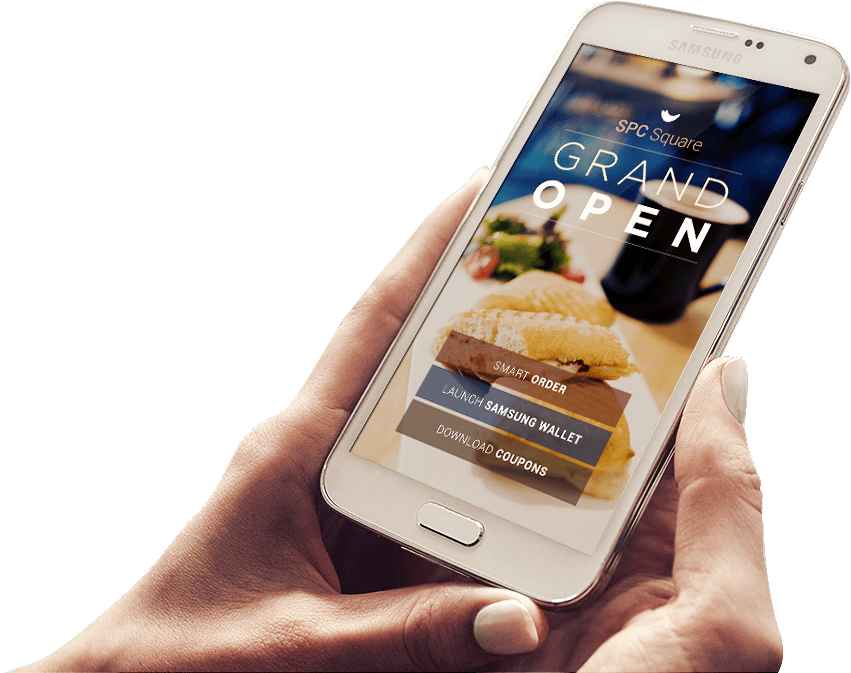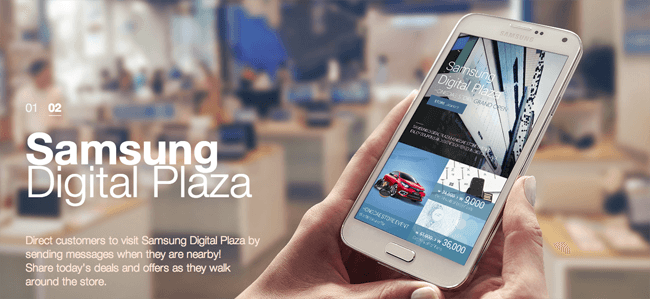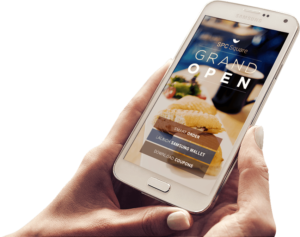
Samsung Makes Its Move: Beacons for Android, No App Required
November 12, 2014 by guest author, Charles Regula

Guest Post: Doug Thompson, Dot3
Samsung will launch the Samsung Placedge Platform at their developer’s conference tomorrow, and with it will cut out the need for an app to detect beacons. Instead, Samsung will provide a sort of uber-application that sits at the device layer, detecting beacons and pushing messages via a shared service.
They invite developers to create their own apps using the Samsung tools, and so a sort of combined experience that allows brands to reach consumers who BOTH have/don’t have an app seems possible. Details of the developer tool kits will be announced at their event tomorrow.
The move by Samsung helps to reinforce that beacons aren’t an Apple-only thing. And it highlights the competition for access to the engagements that happen in place.
Samsung has staked its own territory with Placedge – bypassing the app entirely, giving retailers a full suite of tools to manage campaigns and beacons.
The Placedge website promotes simplicity:
Once the Proximity Service app is installed, dynamic and relevant information and coupons will be pushed to the user’s phone. By leveraging various features provided by the Samsung Proximity Platform, partners can create highly-targeted marketing campaigns to generate more foot traffic and sales.
The platform won’t look dissimilar to the dozens of beacon campaign systems on the market today, from Lighthouse to LocalSocial. But Samsung is taking things a step further by building its own proximity layer and user experience – potentially in conflict with patents held by Apple.
It’s Time for Android
While Bluetooth beacons have become synonymous with the Apple iBeacon brand, the devices are based on the open Bluetooth standard and Android phones with KitKat or higher have been able to detect beacons.
Beacon detection through standards like Radius Networks and its AltBeacon open specification allows app developers to create proximity-based experiences. Deploy a few beacons in your location and both Android and Apple apps can respond to the devices.
But with both platforms you still need an app. And while beacons make proximity experiences possible, they don’t on their own deliver content, coupons or interactions. You still need an app for that, and you usually need a cloud-based content and campaign management system to get it all to work.
There’s No App for That
 Samsung has decided to supplement the app layer by building its own. Sitting on the level of the phone, it provides retailers and brands direct access to consumers and provides a suite of campaign, push message and coupon delivery tools.
Samsung has decided to supplement the app layer by building its own. Sitting on the level of the phone, it provides retailers and brands direct access to consumers and provides a suite of campaign, push message and coupon delivery tools.
In other words, the company has decided to try to own a good chunk of the middle layer between the beacon and the consumer…and will give companies like Urban Airship (which has made a big push into beacons, including through a partnership with Gimbal) a run for their money related to push messages.
Samsung is announcing that its doors are open for partnerships:
‘The Samsung Proximity Partnership Program provides an opportunity for partners to configure and deploy an effective location-based marketing campaign. Samsung would like to support you to make a successful story All you need to do is to register to our proximity service partnership program, and then we will provide the full end-to-end solution. In order to get started, join the Proximity Service’s Web Console with Samsung account. We will verify your account and give you a company code, and you will be ready to go!”
Yet by bypassing the app layer, Samsung is providing brands and developers a way to reach consumers who don’t have your app installed.
They offer developers tools to build on top of this experience, although details remain to be released, with Samsung inviting developers to “Build an app using the Proximity Platform to drive more mobile traffic to your app.”
By building its own infrastructure, Samsung also seems to be making a play for the digital wallet, setting the stage for a showdown with Apple Pay.
You’ll Still Need a Beacon
Samsung has seemingly announced support for “your own beacons” but highlights four companies on its website. No details have yet been released on the configuration requirements for the beacons – whether they have specific requirements for ad intervals or packets, security layers or other features.
Our personal preference has always been Radius Networks if you want something out of the box and ready-to-roll – their work on Android frameworks has always been light years ahead of the industry.
In fact, the company is immediately launching a Placedge-ready beacon and developer kit – so there’s no need to wait, just jump right in and get started:
The Beacon Developer Kit for Samsung Placedge is an early-access kit featuring a proximity beacon for use in development and testing with the Samsung’s mobile proximity platform. This developer kit contains a pre-configured Bluetooth Smart™ beacons implemented in a tiny USB package that can be powered by any available USB power source.
The Early-Access program provides developers access to hardware proximity beacons that are compatible with the Samsung Placedge platform. Users of the kit should recognize that the features, functions and capabilities of beacons that work with the Samsung Placedge platform are subject to change and likely to change during the Early-Access period.
Apple/Samsung Showdown?
Apple made its earliest bets on developers. Whether they continue to let beacons live ONLY at the app layer remains to be seen. With Apple Pay, it won’t take much for them to create a new device-level layer for beacon-detection and payments and to allow developers and apps to tap into that larger ecosystem.
They also have a strong patent portfolio around retail-driven experiences with beacons, and their decision on whether to exercise that portfolio will be an interesting sign of whether the Apple/Samsung patent wars of years past are truly behind us.
But Samsung has made its bet: forget the app, forget beacon campaign management systems – bypass all that and go direct to the consumer with Samsung. Reach consumers who don’t have your app – and (possibly) then migrate them into your own experience, using the Samsung tools and SDK.
How open the system will be to creating experiences AROUND Placedge, how the beacon notices on the Samsung app layer can trigger engagement with a brand’s own app, and how this will be received in the halls of Cupertino are still to be determined.
We’ll learn more at the Samsung Developer’s Conference and in the weeks ahead.
But for now it’s game on. Welcome to the world of beacons, Samsung. Now let’s see how app developers, beacon management companies….and the consumer respond.
This post originally appeared in Beekn, Doug Thompson’s highly respected blog about beacon technology. Based in Toronto, Thompson has a beacons-focused consulting firm, Dot3.



Very informative, thank you for the guest post Doug. One question though is that it seems you still need to an install the proximity service app. I was hoping from the title “No App required” that they are incorporating it at the OS level. Doesn’t seem so. Having to install any app (including one that many people will consider as spam) is an obstacle.
Hi Doug, Android now has support for IBeacon transmissions as of version 5 (lollipop) as per http://www.pozzey.com/massive_improvement_in_android_support_for_ibeacon/ so any device with Bluetooth onboard and upgradeable to 5 will be capable of transmissions and accessible via Android SDK for developers.
Requiring users to install an app to listen to specific beacons is a way to give the user control of what notifications they receive from beacons. While it seems very appealing to marketers to be able to push messages to any phone without requiring the user’s permission, to the user it will be akin to walking into a room and having a crowd of people yelling at you to get your attention. Just imagine once beacons become commonplace. Your phone will be dinging/buzzing every step you take.